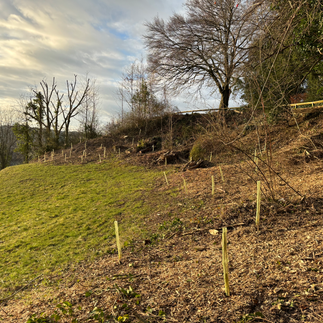The day we planted 100 trees
- Harry Mycock

- Jan 23, 2024
- 3 min read
On 9 December 2023, volunteers from the Friends of St Giles Hill Park and Winchester City Council officers and councillors helped plant 100 new trees on the southern slope of St Giles Hill, where ground clearance works had previously been carried out to remove dead and diseased trees and undergrowth.
Eight different tree species were selected for planting, taking into account the site, soil, tolerances, visual and human interest and their overall biodiversity value - full list and further details, below.
Trees were planted in groups for impact, and also in odd number groups as this creates a more natural look. The tree positions were chosen taking into account the recently reopened views, the eventual and relative sizes of the trees concerned, and necessary aspect.
A huge thank you to everyone who braved the inclement weather and got dug in - literally. The new trees are now settling in to their new surrounds and the Park Friends will be helping to nurture them as they become more established over the coming years.
Our happy band of volunteers at work tree-plating in damp weather on 9 December 2023. (Photo credit: R. Berry).
TREES PLANTED IN THE PARK - 9 DECEMBER 2023
Prunus cerasifera (Cherry Plum)
Early flowering, as early as mid February with a mass of small white and slightly pink flowers.
Bright red, edible, stone fruit which may be eaten raw or in soups and stews or even for making wine or moonshine.
High biodiversity rating from flowers and fruits.
Good drought and wind tolerance.
Small tree around 9m in eventual height
Rhamnus cathartica (European buckthorn)
Yellow-green flowers in the Spring with almost black berries in the winter.
Good biodiversity rating with berries important for several bird species who disperse the seeds.
Sometimes called the Purging buckthorn due to laxative effects if eaten so best left to the birds.
Often used as a shrub in hedges but can become a small tree up to 9m in eventual height.
Cretaegus monogyna (Hawthorn)
Sometimes also known as the May tree as this is when the flowering is most resplendent marking the change from Spring to Summer for many.
It is very useful in supporting very large numbers of other species providing for moths, bees and birds, in particular.
The young leaves, buds and flowers are all edible and work well added to a salad. The raw berries (haws) are best left to the birds as they can lead to stomach upset.
Good drought and wind tolerance. Very much part of the scene of when regeneration is taking place.
Around 8m eventual height.
Malus domestica (Apple)
Flowering in March and April the apple attracts pollinators and is a good food plant all round from caterpillars to humans.
Apples are viewed in many ways – as a forbidden fruit from Greek mythology and Christian tradition though a symbol of strength and fertility in some other cultures.
Humans make use of the fruit in many forms eating them raw, in cooking and to make drinks such as cider.
Good drought and wind tolerance.
Around 8m eventual height.
Pyrus communis (Common Pear)
Not a native in some definitions of the term but the pear has been in Britain since Anglo Saxon times, first recorded in 995AD.
With the pear spring flowering is followed by glossy green leaves in summer and then distinctive shaped fruit in the autumn.
As with apples, pears perform a great role in supporting many species including humans.
Pears will prefer the sunnier areas of the slope and where the soil is likely to be more fertile than on the steeper slopes.
Around 11m eventual height.
Prunus padua (Bird Cherry)
Although the blooming is quite short-lived the bird cherry is quite spectacular when it does. It also gives out a strong almond like scent as part of its attraction for pollinators and humans.
Often used for hedging, it is better suited for woodland, as hedge trimming might lead to silver leaf disease.
Height up to 15m generally, perhaps best planted behind the above listed trees to provide a best show on the slope. Spread to around 8m.
Ulmus glabra (Wych elm)
These larger trees, up to 25-30m eventually, are being used as more strategic plantings. With the loss of the diseased ash trees, which can grow to 35m, some taller canopy trees have been lost in the recent necessary felling. (Examples of some very large ash trees may still be seen to the North of the viewpoint, trees which alas will need to be removed in the next few years due to disease.)
There are around 20 mature English Elm on the Hill and these will most likely continue to succumb to Dutch Elm disease, so the addition of some Wych Elm in the planting mix is in some ways to ameliorate the loss.
The Wych Elm is less susceptible to disease, as are less mature elms, so adding these trees to the mix of planting is of value to the biodiversity and certain endangered butterflies such as the white-letter hairstreak recorded nearby.
The southern slope of St Giles Hill Park with its 100 newly planted trees. (Photo credit: C. Radcliffe).






















Comments